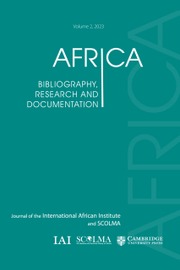No CrossRef data available.
Article contents
Sources on the visual history of African wildlife, 1940s to 1980s: images that changed the animal world
Published online by Cambridge University Press: 20 December 2024
Abstract
We have recently completed the draft of a book on the changing representation of East African wildlife from the 1940s to the 1980s. We have used many published texts as well as visual representations such as photographs, films, and television. The output of material in these years was huge. We suggest that these media representations were a significant, and neglected, element in the emergence of a global animal-centric conservationist ethos. This article discusses some of the people involved and the papers, many of them in private hands, that we used. We believe that this is valuable material and should, where possible, be acquired by archives. The material is scattered, especially in Kenya, the UK, and USA. In the UK, the University of Bristol library now houses the Wildscreen film archives and also some private papers that could form the foundation for a larger collection.
Résumé
Les auteurs ont récemment achevé l’ébauche d’un ouvrage sur l’évolution de la représentation de la faune sauvage d’Afrique de l’Est des années 1940 aux années 1980. Ils ont utilisé de nombreux textes publiés, ainsi que des représentations visuelles telles que photographiques, cinématographiques et télévisuelles. Le volume de matériel produit au cours de cette période est considérable. Les auteurs suggèrent que ces représentations médiatiques ont été un élément important et négligé de l’émergence d’une culture conservationniste mondiale centrée sur les animaux. Cet article présente certaines des personnes impliquées et les documents utilisés, qui appartiennent pour la plupart à des particuliers. Les auteurs pensent qu’il s’agit d’un matériel précieux qui devrait, dans la mesure du possible, être racheté par des archives. Ce matériel est dispersé, notamment au Kenya, au Royaume-Uni et aux États-Unis. Au Royaume-Uni, la bibliothèque de l’Université de Bristol abrite désormais les archives cinématographiques Wildscreen ainsi que certains documents privés qui pourraient constituer la base d’une collection plus vaste.
Information
- Type
- Environmental histories
- Information
- Copyright
- © The Author(s), 2024. Published by Cambridge University Press on behalf of the International African Institute

